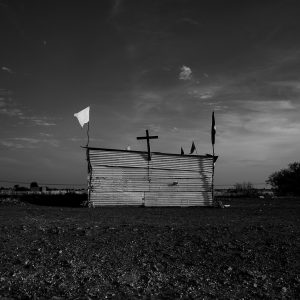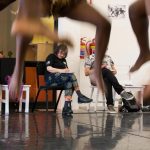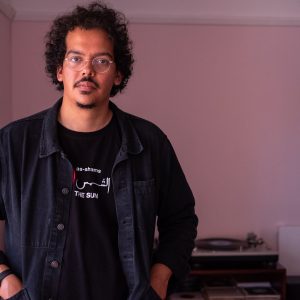Dancers defy Covid-19 by embracing film
Four short dance films are a testament to mentorship, creative collaboration and the refusal of artists to be defeated by Covid-19 and lockdown restrictions.
Author:
3 December 2020

A river runs through Sabelo Cele’s imagination, a liquid thread pulling together the themes the dancer and choreographer can’t easily lay to rest. Water dominates in his dance film, Isabelo, which premieres on Thursday 3 December alongside the works of three other young choreographers.
The four were selected for a mentorship programme to create short dance films following their standout entries to the Jomba! dance festival, which was held online for the first time in its 22-year history in late August-early September.
Members of the Sustaining Theatre and Dance Foundation (Stand Foundation) stepped up as mentors to the choreographers. The not-for-profit foundation was established in the early days of the government’s initial lockdown, in response to the impact of Covid-19 and the merciless blow of lockdown restrictions on creative industries. Gregory Maqoma mentored Cele, Sbonakaliso Ndaba guided Phumlani Mndebele on Descent into Death, Musa Hlatshwayo advised Pavishen Paideya on Rupa and Alfred Hinkel aided Kaldi Makutike to create Thoughts in My Head.
Mentorship, collaboration with Jomba! and the creation of dance in film format are some of the sector-driven responses Stand has facilitated for artists to negate the impact of the coronavirus pandemic, and shift their reliance on fickle government aid and corporate funding.
The site as stage
For Cele, the first blow of the pandemic came when his work in Durban evaporated, forcing him to move home to Ladysmith.
“To stay fit, I jogged around the township and then along the river that’s near the Kenneth Stainbank Nature Reserve. It was very therapeutic for me to be near the water and I knew then that was where I wanted to situate my film. I was also very excited because we were working with film, so the site could become my stage and I was thinking about the cinematography as well as dance for this production,” he says.
The river was healing. It was also symbolic of the syncretism of his traditional African beliefs and his Christian faith. Water is ritual cleansing, baptism, the swirling biblical power of floods and parted seas and a conduit to the ancestors. For Cele, this river was also potently familiar, a marker of being home.
Related article:
At the same time, being at home during the lockdown meant confronting the issues of queer masculinities, toxic masculinities, religion and identity that emerge as themes in his short film.
“Here I was, back home, having to play the masculine uncle role, but also suddenly unemployed and unable to provide like I’m expected to do as a man. I was also not able to go to church, but I needed to stay in touch with my spirituality, my Catholic upbringing and my connection to traditional healing,” says Cele of the way the lockdown instantly reshaped his world.
As the initial 21-day lockdown turned into weeks and then months, he was “confronted with isolation on steroids that presents you with yourself. You can’t ignore yourself and for me that was realising how wounded I am and that I’m still bleeding.”
He expresses these raw and intimate personal traumas, and hopes of healing and transformation, in his film.
Mentoring through bravery
For his mentor, world-acclaimed dancer and choreographer Maqoma, guidance meant helping Cele find ways to bring together seemingly disparate themes and embrace them as his heritage story. It was also about encouraging Cele to keep an open mind and even to trust the way failure acts as a teacher, to get to a final cut of which Cele could be proud.
“Mentoring for me is not having judgement but allowing ideas to go through a process, and then supporting that person to be brave enough to throw out ideas that don’t work,” says Maqoma.
This year marks 30 years in the industry for the Soweto-born dancer who joined Moving Into Dance in 1990. This was the dance company Sylvia Glasser started in her garage in 1978 to include Black dancers in defiance of apartheid’s segregationist laws.
Related article:
“When I look back on my own journey, I recognise how someone like Sylvia helped me to value my own culture in dance even in a time when there was so little room to explore. Today, I draw on my Xhosa culture, history and heritage as my aesthetic. But I’m also an evolving global citizen, so even my personal culture keeps evolving. I might not have got it all at the time as a young dancer, but a seed was planted,” says Maqoma.
Now, in his role as the chairperson of Stand, Maqoma is planting seeds for resilience, for adaption and for more guts and graft when it comes to innovating.
“We have to be able to come together to re-energise the sector, we can’t wait for government,” he says.
The mentorship programme allows industry newcomers to plug into experience and support. Mentorship also acts in reverse, as established professionals are given fresh perspective, reaffirming the value of lifelong learning.
Maqoma says Stand is also working on programmes to support dance practitioners who are nearing the end of their dancing years but are still too young to be pensioned off.
Covid’s realities
Covid-19 was a brutal wake-up call to the vulnerabilities of artists. “People were going hungry. I was receiving messages from people asking for help, even just for a food parcel,” he says. This is how closely the lockdown hit home for Maqoma.
He says this difficult time has also been a moment, though, of reckoning for artists – as creatives, creators and storytellers – to recognise that they need to take the lead in shaping how they emerge from the coronavirus pandemic.
Related article:
“Theatre has resilience. As artists, we have always been able to overcome because we are the people who can break boundaries, open minds, speak truth to power and use our platform to give voice to the oppressed. We tell of the issues that are pertinent to the people. Not even government can do that as well as we can,” he says.
Maqoma points to a long tradition of protest theatre and artists as the tools for resistance. It was the likes of Miriam Makeba’s artistry and then fame that gave her the platform to deliver her 1963 speech to the United Nations calling out the apartheid government. The ANC adopted the slogan “culture is a weapon of struggle”, understanding the power of the arts to connect to the hearts of people.
Interior monologues
The four dance films that have emerged from the mentorship programme all contain themes of ritual and introspection in a time of isolation and uncertainty as connecting points, says Jomba! artistic director Lliane Loots. The dance festival is put on by the University of KwaZulu-Natal’s creative arts department.
Loots says the four entries came from a pool of 60, showing that there is an appetite to explore the presentation of dance in different ways. She says it is through adaptation, play and experimentation that theatre and dance will find renewed relevance.
“Dance is not bound by theatre convention and it has embodied truth. That’s what makes it a critical art form. The four choreographers have shown that they can take chances and make the camera itself a dancer.
“These films may not be Hollywood high-end productions and film may not be able to replace a live performance, but these short films are provocative and edgy and the interior monologues of the choreographers are what viewers will be able to relate to,” she adds.
Touching the hearts of those who watch his film premiere on a screen rather than in the flesh is what Paideya still hopes to achieve.
“The film format can be cut and dry, and there’s no feeding off the vibe of a live audience. But there’s also been the opportunity to work with things like enhanced musicals, costuming and a roaming camera to give audiences a different perspective,” he says.
Related article:
Paideya’s film Rupa is inspired by the movement and artistic distortion of traditional Indian religious iconography. There’s a trance-like quality to it. The interplay of the reality and unreality of traditional sculpture and its relation to the human body becomes dreamlike and surreal, but also Paideya’s truth.
Ultimately, his film is still about the triumph of form and flow. It’s something like Cele’s metaphorical river. It’s the urge to move, the impulse to fill space with the body as expression and trust that an outcome happens, come what may.
The four dance films premiere as a free, 40-minute package on YouTube at 7pm on December 3. They will then be available to view individually on the Jomba! website until 18 December.





